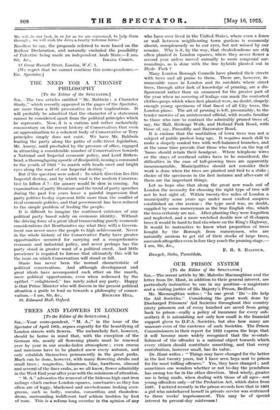TREES AND FLOWERS IN LONDON
[To the Editor of the SPECTATOR.] SIR,—Your correspondent, " M. A.," in the issue of the Spectator of April 18th, argues cogently for the beautifying of London streets with flowers. The melancholy fact, however, should be borne in mind that, with the exception of the German iris, nearly all flowering plants must be renewed year by year in our smoke-laden atmosphere ; even crocus and narcissus have to be planted anew every autumn, and only establish themselves permanently in the great parks. Much can be done, however, with many flowering shrubs and small trees ; magnolias, laburnum, lilac, hawthorn, almond and several of the finer crabs, as we all know, flower admirably in the West End year after year with the minimum of attention.
" M. A." advocates the removal of the hideous high cast-iron railings /Thich enclose London squares, sanctuaries as they too often are of leggy, blackened and unwholesome looking ever- greens, such as holly, aucuba, osrnanthus and rhododen- drons, surrounding indifferent turf seldom trodden by foot of man. This is a reform long overdue in the opinion of any
who have ever lived in the United States, where even a fence- or wall between neighbouring town gardens is commonly absent, conspicuously so to our eyes, but not missed by our cousins. Why is it, by the way, that rhododendrons are stilt often planted in London squares, where they never flower a second year unless moved annually to more congenial sur- roundings, as is done with the fine hybrids planted out in Hyde Park ?
Many London Borough Councils have planted their streets with trees and all praise to them. There are, however, in- numerable cases in London and its outskirts where street trees, through utter lack of knowledge of pruning, are a dis- figurement rather than an ornament for the greater part of the year when no covering of leafage can mask the contorted clothes-props which when first planted were, no doubt, shapely. enough young specimens of that finest of all City trees, the London plane. The art of pruning is left, presumably, to the tender mercies of an uninterested official, with results familiar to those who care to contrast the admirably pruned trees of, say, the Mall, Birdcage Walk, and Holland Park Road, with those of, say, Piccadilly and Bayswater Road.
It is curious that the mutilation of town trees was not a; subject of public protest long ago. It requires much skill to make a shapely conical tree with well-balanced branches, and at the same time provide that those who travel on the top of 'buses should retain their headgear. Where telephone wires or the stays of overhead cables have to be considered, tho difficulties in the case of tall-growing trees are apparently, insurmountable. Municipalities should not consider their. work is done when the trees are planted and tied to a stake ; choice of the specimens in the first instance and after-care of them are the important things.
Let us hope also that along the great new roads out of London the necessity for choosing the right type of tree will not be lost sight of. Within twenty-five miles of London a. municipality some years ago under most exalted auspices established an elm avenue ; the type used was, no doubt, supplied by some nurseryman as the true English elm, which the trees certainly are not. After planting they were forgotten and neglected, and a more wretched double row of ill-shapers trees it would be hard to find elsewhere on the King's Highway, It would be instructive to know what proportion of trees bought by the Borough from nurserymen, who are naturally anxious to get rid of their stocks of large trees, succumb altogether even before they reach the pruning stage.— I am, Sir, &c.,










































 Previous page
Previous page